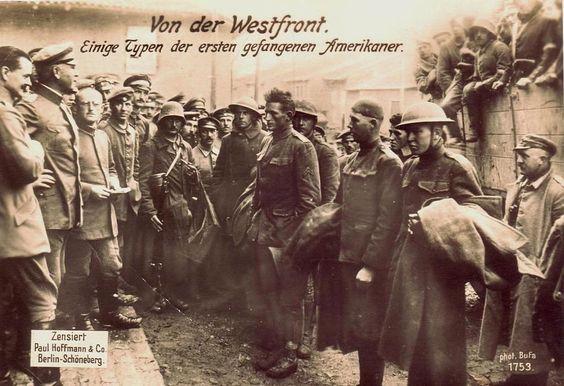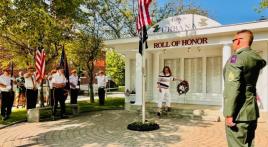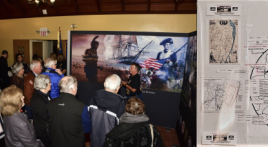National POW/MIA Recognition Day is September 21. The observance is one of six days mandated by Congress for the flying of the National League of Families’ POW/MIA flag.
Around 4,120 American soldiers, sailors and airmen were held as prisoners of war by imperial Germany in the First World War. Over 240 American merchant mariners were captured at sea by German merchant raiders and U-boats. Many of these were released prior to the official U.S. entry into the conflict. There were at least 15 U.S. Navy POWs and 170 Air Service captives. The majority were in the U.S. Army or Marines.
Among the first was Army Sergeant Edgar Halyburton of North Carolina. His POW leadership ensured the survival of about 50 other POWs in the harshest of conditions while on starvation rations. Eventually moved to a concentration point for American enlisted men, Halyburton assumed command of over 2,200 POWs leading resistance to German propaganda efforts, ensuring the health and welfare of his men and running an internal intelligence organization that aided escape efforts and thwarted German collaborators. On release Halyburton was recommended for a commission and was awarded the Distinguished Service Medal, the first enlisted man to receive an award normally reserved for senior officers.
Virginia native Sergeant Palmer Boyd, a medical corpsman with the 38th Infantry, wrote a brief memoir detailing his POW experience. While being processed, he and other doughboys discovered they were being funneled through a building to be interrogated. The men conspired to tell the same story to ensure the German interrogator only obtained limited information. It was an early example of POW group resistance. As a POW barracks chief, he kept fellow POWs off work details aiding the German war effort. In another quick-thinking action, Boyd had about 75 American POWs, all newly arrived from the front, cut off the leather straps and rubber headbands from their helmets before the items could be confiscated. The Germans recycled those materials for their war effort. Though a captive, Boyd continued to fight on the POW battlefield.
Nearly 200 Americans serving in a ‘foreign’ uniform were POWs. These include 134 men in Canadian service who either left the U.S. to enlist or, on discharge, returned to the United States. Thirty-two were in the Royal Flying Corps. Several U.S. military doctors on loan to and serving in the British Army were also captured. Eight Americans were seized while serving in the French Foreign Legion and 16 were in the Lafayette Flying Corps, which included the famed Lafayette Escadrille.
The first American to become a prisoner of war was wearing a French uniform. Russell A. Kelly of New York, a 1914 graduate of Virginia Military Institute, was a Color Bearer with the 2nd Regiment du March of the French Foreign Legion. In battle on June 17, 1915 Kelly was “seen to fall with a ghastly wound, and it was learned that he was a prisoner and had his leg amputated”. He died in captivity. Kelly’s capture occurred three months before French Air Service pilot James J. Bach who is often credited as the first American POW in World War I.
American POWs became active in the ‘escape game,’ with 113 making successful ‘home runs’ into friendly or neutral lines. Most of these were enlisted men. The first successful escape from a permanent POW camp was a merchant mariner identified as Charles Willet Smith of Norwalk, Connecticut. He reached neutral Sweden on October 10, 1917. He was followed a month later by Patrick O’Brien of Momence, Illinois, a member of the Royal Flying Corps. Once the U.S. entered the war, the close-in trench fighting led to events where men were captured but, before led out of battle zone, were able to make their escape and cross ‘No Man’s Land’ to friendly lines. The first American soldier to successfully escape from a permanent POW camp was Private Frank Sovicki of Shenandoah, Pennsylvania. He crossed into Switzerland on October 9, 1918.
One of the more famous POWs was Navy Lieutenant Edouard Isaacs. He helped mastermind a group escape from Villingen POW camp on October 6, 1918. Of 13 men making the escape, only three succeeded in crossing into neutral Switzerland. Isaacs was one of three crossing into Switzerland. He reached freedom on October 13, 1918 and was awarded the Medal of Honor for his feat and for bringing back information of intelligence value. A native of Iowa, Isaacs served ten years in Congress as a representative of California. He died in Fairfax, Virginia in 1990 at the age of 98, the last living Medal of Honor recipient from World War I.
This year’s logo on the Department of Defense POW/MIA Recognition Day poster is ‘Noble Mission, Global Effort’. It depicts the flags of nations that have helped aid U.S. MIA recovery efforts. Many of them are also allies in the Global War on Terror. Some of them were qllies in the First World War. This year’s image is appropriate in this World War I centenary. It was the United States’ first truly ‘global effort’ for a ‘noble mission’; that of making the world safe for democracy. Our POWs were in middle of that fight. Let us remember them.

Remembering First World War POWs in a noble mission
September 19, 2018
About the author:
Colonel Greg Eanes, USAF (retired), is the former deputy chief of the Intelligence Community POW/MIA Analytic Cell and expert in POW/MIA intelligence issues. He is currently a visiting lecturer at the Samuel V. Wilson Center for Leadership in the Public Interest at Hampden-Sydney College near Farmville, Va. His book 'Captured, Not Conquered: The American POW Experience in the First World War' was released in April. He is a member of American Legion Post 50 in Crewe, Va.




